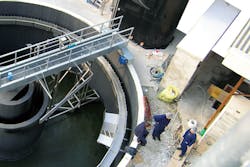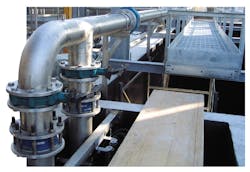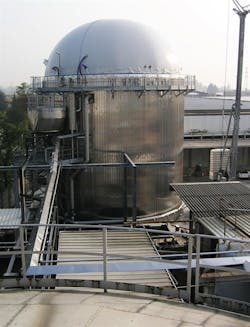Food and beverage production is a strong water and energy consumer. Water consumption is usually measured using the concept “virtual water,” or the quantity of water needed to produce goods. The virtual water to produce one kilo of beef is about 15,500 liters, and for one kilo of sugar it is about 1,500 liters. On the other side, 1 to 7 liters of water is used in the process of refining about 1 liter of gasoline. It is evident that the food and beverage industry draws huge quantities of water and, with the water footprint becoming increasingly visible in the eyes of consumers, the industry is under pressure to reduce its consumption.
To reduce water consumption, companies should improve their manufacturing processes through a combination of changing behavior, adjusting and/or replacing equipment with water-saving equipment to reduce overall water consumption, and increase internal reuse. Internal reuse of wastewater from manufacturing is a valuable method to meet the current environmental standards and save on energy and operation, as well as maintenance costs.
The promise of biological wastewater treatment
Whether preparing for disposal or reuse, wastewater must be treated with the appropriate technologies. The wastewater from food and beverage manufacturing is especially turbid, high in total suspended solids (TSS), chemical oxygen demands (COD), biological oxygen demand (BOD), fats, oils and grease (FOG), and usually nutrients such as nitrogen (including ammonia) and phosphate. Because of the characteristics of these streams, biological treatment systems are the most suitable to recover the waste streams, treating them for discharge within law limits to reuse them. Biological wastewater treatment, particularly anaerobic digestion, is an excellent choice, and it is becoming popular because the investment in the technology pays for itself through biogas production.
Anaerobic digestion is the simple, natural breakdown of organic matter into methane, carbon dioxide and water by microorganisms. At the end of the process, we have a mixture of methane and carbon dioxide gases (called biogas) and suspension of organic material (digestate), which contains the organic material that has not been degraded, plus the anaerobic bacteria. Biogas can be burned to produce both heat and electricity, or it can be further purified to produce methane, which can be used as vehicle fuel or injected into the gas grid.
Aerobic system, including pumps, tubing and valves
The wastewater challenge for the food and beverage industry
Water consumption is a pressing matter for Italcanditi-Vitalfood, one of the biggest players in Europe for the production of glazed chestnuts, assorted candies, jams, and other ingredients for the food, bakery and dairy industries. Based in the north of Italy, the company is required to dispose of the increasing industrial wastewater effluents from fruit, candies and jam in a cost-effective way. Due to a production growth, Italcanditi-Vitalfood needed to boost its wastewater treatment capabilities. Based on the success of an earlier project, the company chose Fluence Corporation to install and operate a new system for turning wastewater into biogas.
Fluence, an international company with a wide range of solutions for wastewater, waste-to-energy, and food and beverage processing, has developed innovative technologies to transform biological waste – including wastewater – into energy through biological wastewater treatments.
The first challenge Fluence faced in working with Italcanditi-Vitalfood was handling the complicated wastewater streams and treating them for disposal within legal limits or for reuse. One advantage of this application was the COD levels, which made it a good fit for anaerobic digestion. The higher the COD, the higher the energy content of wastes and/or wastewater. It is useful to know that 1 kg of COD, treated by an anaerobic digestion process, produces 0.35 cubic meters of methane, which can be reused in the processing system as combustible.
Anaerobic digestion treatment and process
Italcanditi-Vitalfood chose anaerobic digestion as a way to exploit its wastewater for profit. First, the wastewater entering the system underwent an anaerobic pretreatment through an EFC (external forced circulation) reactor, generating biogas. A cogeneration system then turned the biogas into electrical and thermal energy, which was fed back into the plant, reducing energy costs.
The EFC reactor was an evolution of an up-flow anaerobic sludge blanket (UASB) reactor completely designed and developed by Fluence. An increased flow velocity accomplished by incorporating an effluent recycle permitted partial expansion of the granular sludge bed, improving wastewater-sludge contact, as well as enhancing segregation of small, inactive suspended particle from the sludge bed. The anaerobic reaction was rapid because the large quantity of anaerobic activated sludge permitted abatement of the soluble organic contamination, with very low retention times (6 – 48 h) and with high organic loads (6 – 15 kg COD/m3/day).
The anaerobic digestion produced a pretreated wastewater stream with a specific level of COD and nitrogen. If disposed of without treatment, the nitrogen could penetrate the soil and contaminate groundwater. Therefore, the remaining wastewater was treated by an aerobic stage, supported by biological oxidation and final clarification. The output was water that is clean, reusable and safe for the environment.
External forced circulation (EFC) reactor
Considering space constraints
Another challenge in the design and construction of wastewater treatment plants for food and beverage industry is managing space constraints. These plants are usually located close to conurbations, meaning that land prices are high or land for expansion is not available at all.
In the case of Italcanditi-Vitalfood, located in the industrial area of a small city in the north of Italy, the available space was very limited and the production cycle of 16 hours a day, six days a week could not be affected. Fluence accomplished this by customizing the design and build to the client’s needs, employing an EFC reactor that is, in fact, easy to set up in limited spaces and/or in peculiar locations thanks to its simple design and resistance to disturbances.
Evaluate solutions for biological wastewater treatment
Biological wastewater treatment is the most suitable solution for treating wastewater with high carbon or nitrogen content, as in the food and beverage industry waste streams. And tightening regulations for wastewater treatment worldwide, as well as international commitments to reduce fossil fuels and address water scarcity, have created a growing market for biological wastewater treatment.
Biological wastewater treatment is the most suitable solution for treating wastewater with high carbon or nitrogen content, as in the food and beverage industry waste streams.
Meanwhile, the opportunity to produce renewable energy and cut energy costs make the production of biogas an appealing option for many industries. The advanced maintenance and operation skills necessary to maintain such systems could hinder their adoption, but thanks to Fluence’s skilled engineers and technicians, Italcanditi-Vitalfood was able to realize the benefits of biological wastewater treatment.
Compared to the use of sole aerobic solutions, adding anaerobic treatments also limits the problem of excess secondary sludge. It is usually produced with the use of aerobic systems, and its disposal represents an additional cost for the company. The sludge produced in the EFC reactor is only 5 percent of the destroyed COD – compared to the 40 to 45 percent of the aerobic process.
Final results
Italcanditi-Vitalfood saves about $400,000 each year with Fluence’s anaerobic digester, approximately 35 to 40 percent more compared to the previous treatment plant. After several years of operation, the plant still proves its efficiency with a flow rate of 1,200 m3/d or 50 m3/h, biogas production of 4,800 m3/d, and electricity generation of about 14 MWh/d. Chemical oxygen demand is measured at 12,000 mg/L.
Biological wastewater treatment tackles most wastewater challenges in the food and beverage industry. Difficult wastewater streams are converted into renewable energy, which can be fed back into the manufacturing process in the form of heat and electricity. The combination of aerobic and anaerobic solutions is a recipe to maximize energy production and minimize energy costs for the food and beverage industry. This solution is also relevant for other industries where high organic soluble compounds are found in effluents, such as paper mills.
Fabio Poletto is vice president of sales and marketing, Italy, for Fluence Corporation. With a background in water treatment technologies for the food and beverage industry, Poletto has carried out innovative research on nitrification and denitrification treatments, anaerobic digestion and chemical-physical wastewater treatments. He has a master’s degree in chemistry from the University of Padua, specializing in innovative chemical technologies. He can be reached at [email protected].



